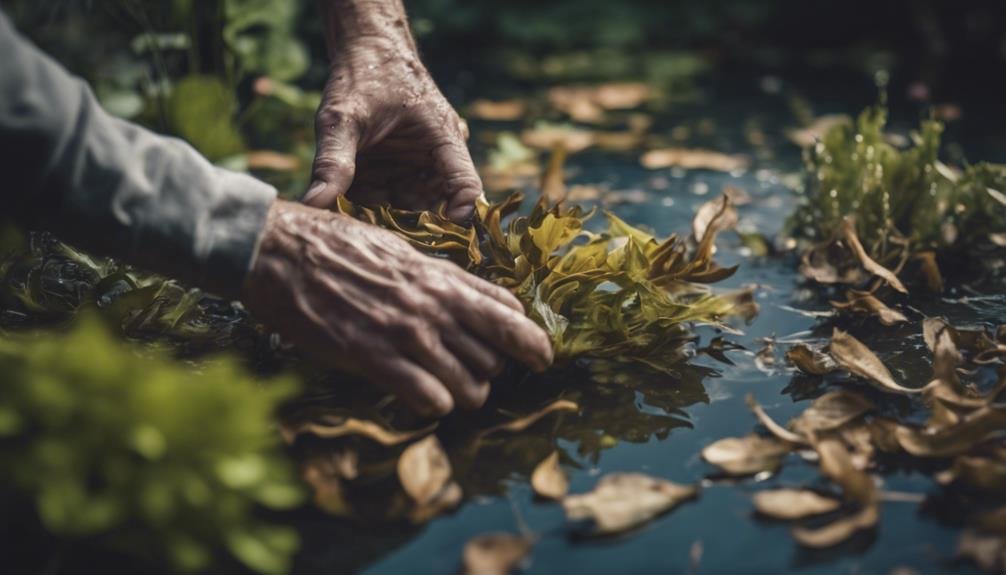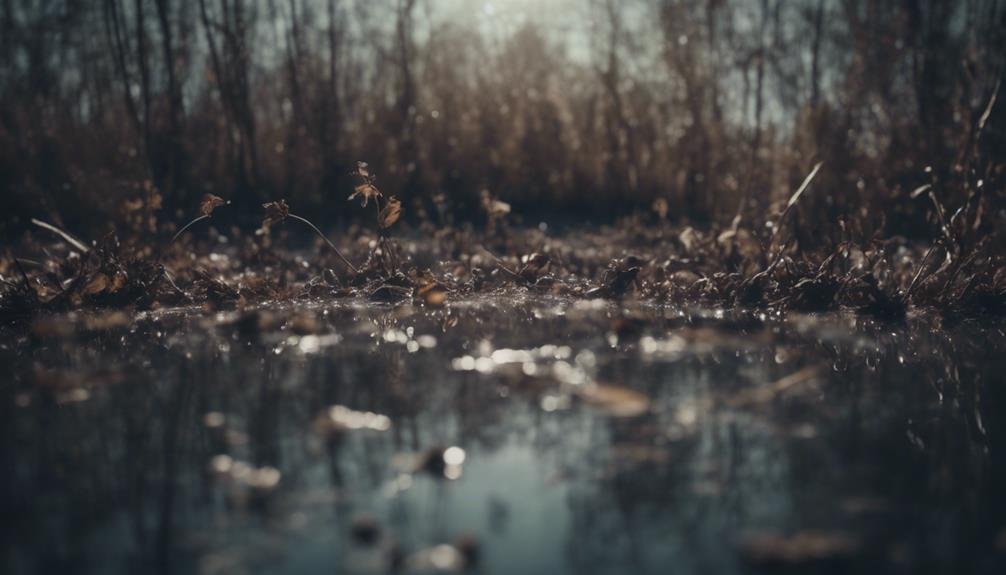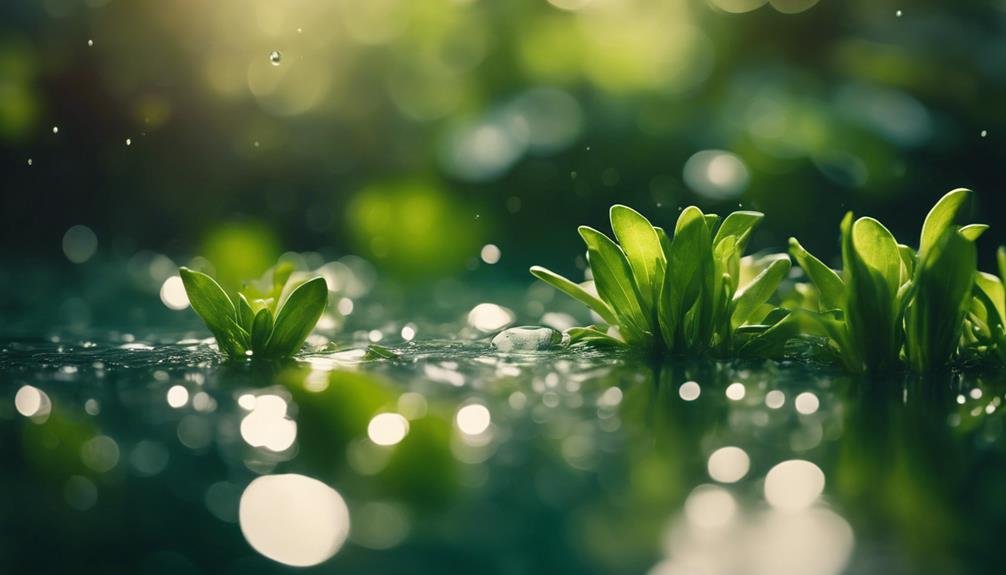To protect our pond plants from freezing temperatures, it's essential to use float pond heaters and insulating materials like burlap or styrofoam. These measures help prevent damage and maintain a stable environment for the plants.
Some of the links in this article may be affiliate links. If you make a purchase through these links, we may earn a small commission at no extra cost to you. Thank you.
Additionally, removing dead foliage and replenishing water levels with dechlorinated water are crucial steps in winter care.
Creating an insulation layer using mulch or leaves can further help regulate temperatures and protect the plants from the harsh cold. Regular monitoring for issues such as freezing injuries or pests is important so that adjustments can be made promptly.
As winter comes to an end, tending to the plants by trimming dead growth and assessing fertilizer needs will promote healthy development in the upcoming seasons.
By following these steps and staying attentive to the plants' needs, we can ensure they thrive despite the winter chill.
Understand Plant Needs
To effectively care for our pond plants during winter, it's crucial to understand their specific needs for optimal health and growth. Each type of pond plant has unique requirements for sunlight exposure, water temperature, and nutrient levels. Some plants are resilient and can endure freezing temperatures, while others, such as tropical varieties, need special attention like being moved indoors or into a heated greenhouse.
Researching the plants in our pond and learning about their care instructions is essential. For instance, hardy water lilies can survive the winter if the water doesn't freeze entirely, but tropical lilies must be taken out and stored in a cool, dry area.
Marginal plants like cattails and rushes can usually stay in the pond but might need pruning and insulation with mulch or burlap for added protection.
Understanding the specific needs of each pond plant and following the appropriate care guidelines will help ensure their survival and well-being during the winter season. By taking these proactive measures, we can enjoy a healthy and vibrant pond ecosystem year-round.
Protect From Freezing
To protect pond plants from freezing in winter, consider using float pond heaters to keep a small area of water open. Additionally, covering the pond's surface with insulating materials like boards or foam can help prevent ice formation.
For potted plants, insulate the containers with burlap or styrofoam sheets to safeguard the roots from extreme cold. These measures are essential for maintaining the health of the plants and ensuring they survive the harsh winter conditions.
Float Pond Heaters
Using float pond heaters is a smart way to protect aquatic plants from freezing temperatures in winter. These devices work by circulating the water gently to prevent it from freezing completely, which could harm submerged plants by cutting off their oxygen and light supply. There are different types of float heaters available, each with unique features and capacities.
You can choose from floating de-icers, submersible de-icers, and cabinet heaters. Floating de-icers are thermostatically controlled and typically range from 1,500 to 3,000 watts in size. Submersible de-icers have a fully submerged heating element and vary from 300 to 1,500 watts. Cabinet heaters are enclosed units with a fan, ranging from 3,000 to 6,000 watts in size.
Selecting the right size heater is crucial to ensure it effectively maintains an ice-free area. An undersized heater may struggle to keep the water from freezing, while an oversized one can be inefficient.
Proper installation and maintenance are also important to maximize the heaters' effectiveness and durability.
Cover Water Surface
Covering a pond's surface can protect aquatic plants from harsh winter conditions and potential freezing. Various materials like floating pond covers, polystyrene boards, burlap, or hay can be used to create a shield over the water. Before covering the pond, remove any decaying plant matter to prevent water pollution. Ensure there are openings in the cover for gas exchange and secure it properly to prevent it from blowing away.
Covering the water surface helps maintain a stable temperature and prevents thick ice formation that can damage plants and pond liners. Regular monitoring is essential, and remove the cover during warmer periods to prevent overheating. This practice allows sunlight to reach the plants.
Insulate Plant Containers
When growing hardy aquatic plants in containers during winter, it's crucial to protect them from freezing. One way to do this is by insulating the containers. You can wrap them in bubble wrap or foam sheets to provide a layer of protection.
Another option is to bury the pots in the ground and cover them with mulch or leaves. Alternatively, you can move the containers into an unheated garage or shed for added insulation.
Each method has its pros and cons. Bubble wrap is cost-effective and reusable, but may require extra protection. Foam sheets offer good insulation but can be pricey. Burying pots provides excellent insulation, although it may be challenging to access the plants. Placing containers in an unheated shed allows for easy access but might still need additional insulation.
Regardless of the method chosen, the goal is to safeguard the plants' root systems from freezing temperatures. With proper insulation, your pond plants can endure the winter and flourish once spring arrives.
Remove Dead Foliage

To keep our pond plants healthy, it's important to prune off any dead foliage. By cutting away wilted leaves and stems, we can prevent decay and diseases, which will encourage better growth when spring arrives.
This simple task of tidying up the plants may seem small but it has significant benefits in the long term. Plus, it gives our pond a neat and well-maintained appearance.
Trimming Instructions
To maintain a visually appealing pond and prevent water pollution from decaying foliage, it's important to trim dead or unsightly plant material before winter arrives. Use sharp, clean pruners or scissors to make precise cuts, removing any brown, mushy, or damaged leaves and stems at the base. Be careful to leave healthy green growth untouched, as this will help the plants survive the winter. Dispose of the trimmed material in a compost pile or away from the pond to prevent contamination.
It is crucial not to over-prune aquatic plants during the fall season. Leave some foliage intact so that the plants can continue to photosynthesize and store energy for the upcoming spring growth. For hardy water lilies and lotuses, focus on removing only the dead or damaged portions above the water line. Submerged oxygenating plants like anacharis can have up to one-third of their length trimmed back. Marginal plants such as cattails may require minimal trimming.
Cutting Benefits
Trimming dead and decaying foliage from aquatic plants is essential for several reasons. By cutting away this decaying matter, we're preventing the spread of harmful bacteria and fungi that can cause diseases in healthy plants. Additionally, we're reducing the nutrients that fuel algal blooms, which can be detrimental to the overall health of the aquatic ecosystem.
Moreover, removing rotting leaves and stems helps maintain good water quality and clarity by preventing the accumulation of excess detritus on the pond floor. This debris can deplete oxygen levels as it breaks down, leading to stressful conditions for both fish and plants. Keeping decay under control is crucial for the well-being of the aquatic environment.
Another benefit of trimming is that it prepares the plants for their winter dormancy period. By removing dying foliage that the plants naturally shed, we're redirecting their energy into strengthening their root systems. This preparation maximizes their chances of surviving the cold months ahead.
Replenish Water Levels
During winter, pond water levels naturally decrease due to reduced rainfall and evaporation. It's crucial to regularly replenish the water to prevent harm to plants and wildlife.
Monitoring the water level weekly and adding dechlorinated tap water or rainwater using a garden hose or buckets can help maintain appropriate levels. Avoid using water from a water softener as the salt can harm aquatic life.
When adding water, do so gradually to prevent stress on fish and plants due to sudden temperature changes. If the pond has fish, ensure a section of the surface remains unfrozen for proper gas exchange.
Provide Insulation Layer

To protect pond plants from harsh winter conditions, it's crucial to create an effective insulation layer. This layer, typically made of mulch or leaf litter, covers the entire surface of the pond without disturbing submerged plants. By providing insulation, the layer prevents the water from freezing completely and allows gases to escape, while also regulating temperature changes that could harm the plants.
Aiming for a thickness of 6-8 inches, materials like shredded leaves, straw, or burlap are ideal for this purpose as they don't compact too tightly. As the mulch decomposes during winter, it releases nutrients into the water, benefiting the plants when spring arrives. It's important to leave the insulating layer undisturbed until temperatures consistently warm up in early spring. At that point, the layer can be carefully removed to allow seasonal growth to resume.
This simple step significantly increases the likelihood of pond plants surviving the winter cold. By providing this protective blanket, pond plants are better equipped to withstand the challenges of winter and thrive when the weather warms up again.
Monitor Plant Health
While insulating plants during winter helps them survive, it's crucial to monitor their health closely to ensure proper dormancy.
Various issues can affect plants in cold weather, such as freezing injuries from temperature fluctuations, disease or pest infestations due to weakened plants, lack of oxygen under thick ice coverings, and desiccation from harsh winds and low humidity.
To check on submerged plants, gently lift the insulation layer and examine their color and texture. Healthy plants will appear green and firm, while any browning or mushy foliage indicates problems.
For floating plants, it's essential to peek under any protective coverings for signs of distress like yellowing leaves, wilting stems, excessive leaf drop, or presence of pests or disease.
If any issues arise, adjustments to the overwintering setup, supplemental aeration, or proactive disease treatments may be necessary.
Spring Pond Revival

As the winter cold fades away, we carefully tend to our pond plants in preparation for their rejuvenation. With the days getting longer and the temperatures warming up, we eagerly anticipate the revival of our aquatic gardens. The dormant plants will soon start showing new growth, bringing back the lively energy to the ecosystem.
It is crucial during this transition period to ensure that the pond environment remains clean and well-balanced. Removing any winter debris is essential to maintain proper water flow and oxygen levels. Introducing beneficial bacteria and enzymes gradually will help kickstart the pond's natural processes.
Once the new growth starts emerging, we'll trim away any dead or damaged foliage to promote the healthy development of fresh shoots. Careful pruning won't only encourage dense and robust plants but also prevent overcrowding. Assessing the need for additional fertilizers to replenish essential nutrients depleted during dormancy is also important.
As spring unfolds, our dedicated efforts will pay off, resulting in a revitalized pond filled with vibrant plant life. With patience and proper care, we'll soon witness the beauty of our aquatic oasis in full bloom, ready to bring joy and inspiration throughout the upcoming warmer months.
Conclusion
As the pond plants rest beneath their winter cover, we too can take this time to rejuvenate and prepare for the coming spring.
By tending to our aquatic flora with care during the chilly season, we set the stage for a beautiful burst of growth when the weather warms up.
Just like eager gardeners eagerly anticipating the first signs of life in their gardens, we'll observe closely and welcome the revival of the season with excitement.

